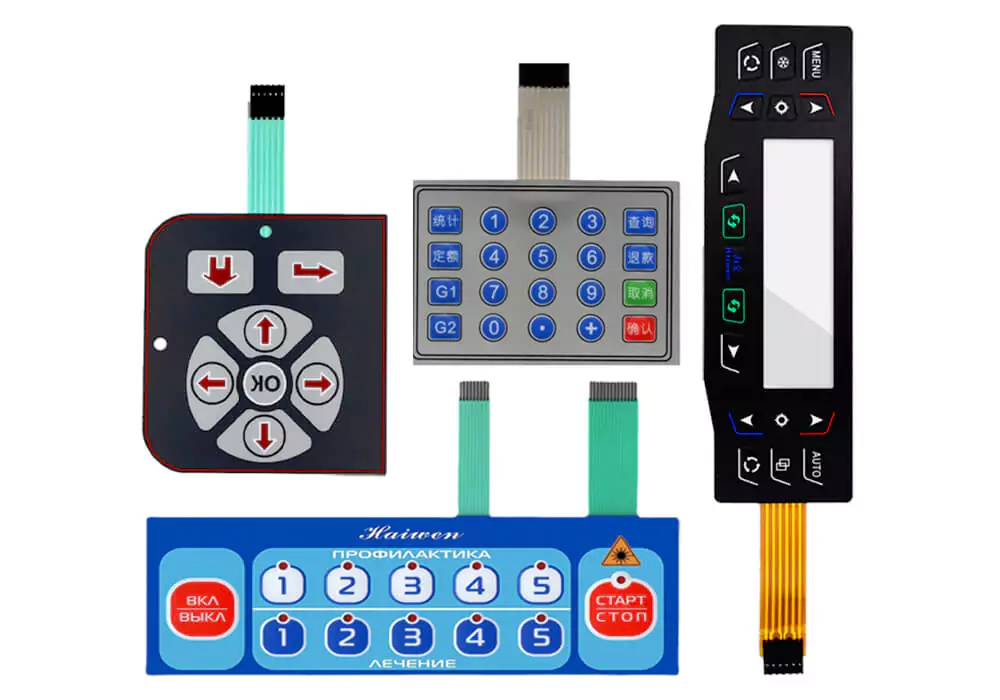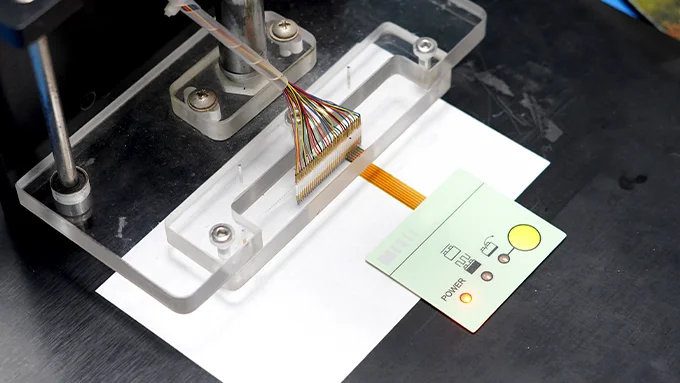The Production Process Behind Membrane Switch Over: What You Need to Know
The manufacturing procedure behind membrane layer switches combines careful style, material choice, and quality assurance. It starts with understanding the intricacies of membrane switch style and proceeds with various stages, consisting of product choices and printing techniques. Each phase plays an important role in ensuring performance and resilience. The complexities of layer building and construction and the rigorous testing criteria may expose understandings that are not immediately evident. What exists beyond these foundational aspects?
Understanding Membrane Switch Style
Although membrane buttons might show up straightforward initially glimpse, their layout entails intricate factors to consider that guarantee performance and longevity. The design process begins with a complete understanding of customer needs, consisting of the user interface's desired application and ecological factors. Ergonomics is a crucial element, as the layout should help with simplicity of use while guaranteeing that tactile feedback meets user expectations.Moreover, the layering of parts, such as visuals overlays, glue layers, and conductive traces, have to be specifically crafted. membrane switch. This layered setup not only influences the button's responsiveness yet likewise affects its longevity. Attention is offered to the securing strategies utilized to safeguard against moisture and dirt, which might jeopardize performance. In addition, style considerations extend to visual appeals, where color pattern and visual clarity boost customer experience. Eventually, the design of membrane layer changes balances capability, individual experience, and sturdiness, ensuring that they fulfill the demands of various applications properly
Materials Made Use Of in Membrane Layer Switch Production
When selecting products for membrane button manufacturing, it is important to ponder both performance and durability. The main materials consist of polyester and polycarbonate movies, which supply flexibility and toughness. These films are usually coated with glue to guarantee correct bonding to substrates. Conductive inks, normally composed of silver or carbon, are essential for producing electric connections within the button, enabling reputable operation.Additionally, a safety layer, such as a hard layer, is regularly related to boost scratch resistance and durability. The selection of backing product, such as acrylic or foam, can significantly affect the button's tactile feel and general user experience. Additionally, various ecological elements, consisting of temperature level and humidity, must lead material selection to ensure peak efficiency in specific applications. Inevitably, the right combination of materials adds to the membrane layer button's capability and lifespan, making informed choices vital for suppliers.
The Printing Refine: Creating Video and Text
The printing procedure in membrane layer button production plays a substantial duty in producing top quality graphics and text. Various graphic design techniques are employed to guarantee aesthetic allure and capability, while mindful ink option approaches are crucial for durability and efficiency. Recognizing these components is basic for accomplishing finest cause membrane switch layout.
Graphic Design Techniques
Graphic layout methods play a necessary function in the printing procedure of membrane layer switches, as they specify exactly how graphics and text will inevitably show up on the end product. Efficient visuals layout includes the strategic use formats, colors, and typefaces to enhance readability and aesthetic appeal. Developers frequently make use of vector graphics for scalability, guaranteeing that photos stay sharp at numerous sizes. In addition, attention to comparison and alignment is important, as it affects customer interaction and visual quality. The unification of branding elements, such as logos, have to be managed with care to maintain brand integrity. In general, thoughtful visuals style techniques contribute substantially to the functionality and appearance of membrane buttons, influencing user experience and product efficiency.
Ink Selection Techniques
Picking the appropriate ink is necessary for attaining the desired visual high quality and durability in membrane switch manufacturing. Numerous ink kinds are utilized, including solvent-based, water-based, and UV-curable inks. Each type uses distinctive features, such as resistance, adhesion, and flexibility to environmental elements. Solvent-based inks are typically preferred for their toughness and vivid shades, while water-based inks are extra eco-friendly yet might have limitations in adhesion. UV-curable inks provide rapid curing and durable efficiency. In addition, shade matching methods ensure that the chosen inks align with design specifications. Inevitably, the selection of ink have to take into consideration aspects such as application technique, substrate compatibility, and end-use requirements to achieve premium outcomes in membrane layer switch graphics and text.
Layer Building And Construction and Setting Up

Product Selection Process
A cautious choice of products is crucial in the manufacturing process of membrane switches, as it directly influences performance and longevity. The primary materials used include polyester, polycarbonate, and different conductive inks. Polyester is usually preferred for its excellent resistance to chemicals and abrasion, making it suitable for harsh environments. Polycarbonate, on the other hand, offers remarkable clearness and effect resistance, which is helpful for applications calling for presence and effectiveness. Conductive inks, commonly made up of silver or carbon, are essential for developing trusted electric pathways. In addition, the selection of glue products affects the overall integrity of the switch - membrane switch. Reviewing variables such as ecological exposure, tactile feedback, and visual demands guides producers in selecting the best materials for their details applications
Layer Attachment Methods
Adhering layers in membrane layer button building is a vital procedure that ensures functionality and longevity. Numerous bond techniques are used to secure excellent bonding in navigate here between layers, which usually include making use of adhesives, heat, and stress. Pressure-sensitive adhesives (PSAs) are frequently utilized for their convenience of application and instant bonding capabilities. Furthermore, thermal bonding techniques can be used, where heat is made use of to trigger glue buildings, protecting a solid bond. The option of attachment technique greatly depends upon the products included and the details application demands of the membrane layer switch. Appropriate alignment and uniform application of adhesives are vital to stop defects, protecting the button operates successfully throughout its intended life expectancy.
Quality Assurance Steps
Assuring quality control during the layer building and construction and assembly of membrane buttons is essential for preserving efficiency and integrity. This process normally entails a number of important measures, including complete examinations at each stage of production. Makers make use of advanced testing techniques, such as peel examinations and attachment analyses, to verify the integrity of layer bonds. Furthermore, aesthetic examinations are conducted to identify any type of flaws in printing or product variances. Ecological problems, such as temperature level and moisture, are carefully monitored to guarantee optimal treating and bond. Additionally, normal calibration of tools assists keep specific production criteria. By executing these top quality control actions, suppliers can significantly decrease the danger of product failure, ensuring that the last membrane layer changes satisfy the needed specs and customer expectations.
Testing and Quality Assurance Steps

Advancements in Membrane Switch Modern Technology
As innovations in innovation remain to evolve, membrane layer buttons are gaining from innovative growths that boost their performance and user experience. One remarkable technology is the combination of capacitive touch innovation, which enables more instinctive and receptive interface. This change not only improves aesthetics yet likewise decreases mechanical go now wear and tear, prolonging the lifespan of the switches.Additionally, innovations in visuals overlay materials have actually led to boosted toughness and resistance to environmental variables such as wetness and UV light. These products currently offer improved clarity and illumination, further raising the aesthetic appeal.Furthermore, the consolidation of clever innovation is changing membrane switches over into interactive control board, enabling connection with IoT devices. This connection fosters a smooth user experience, leading the way for applications in numerous industries, from health care to customer electronics. Collectively, these innovations setting membrane changes as essential parts in contemporary tool design.
Often Asked Questions
Just how Long Does the Membrane Layer Switch Over Manufacturing Refine Take?
The period of the membrane button manufacturing procedure can vary substantially. Factors such as complexity, products made use of, and manufacturing volume influence timelines, with normal manufacturing varying from a few days to several weeks for completion.
What Are the Typical Applications for Membrane Layer Buttons?
Membrane layer buttons are commonly utilized in various markets, consisting of auto controls, household home appliances, clinical tools, and customer electronic devices (membrane switch). Their versatility and resilience make them suitable for applications needing easy to use user interfaces and trusted efficiency in varied atmospheres
Can Membrane Switches Be Customized for Specific Demands?

What Is the Life-span of a Common Membrane Change?
The life-span of a typical membrane switch varies, however usually, it varies from 1 to 5 million cycles. Factors such as usage, environment, and material high quality considerably affect longevity and overall performance over time.

Are Membrane Layer Switches Over Eco Pleasant?
The ecological friendliness of membrane switches differs. Some products utilized may not be recyclable, while others can be environmentally friendly. The overall impact depends on making materials and practices, demanding mindful factor to consider during selection and disposal. The production process behind membrane switches over combines mindful style, material option, and high quality control. It begins with understanding the details of membrane layer switch layout and advances through various phases, including product options and printing techniques. When picking products for membrane button manufacturing, it is essential to ponder both performance and durability. A mindful choice of products is necessary in the manufacturing procedure of membrane switches, as it straight influences capability and toughness. The choice of attachment method greatly depends on the materials entailed and the particular application needs of the membrane button.